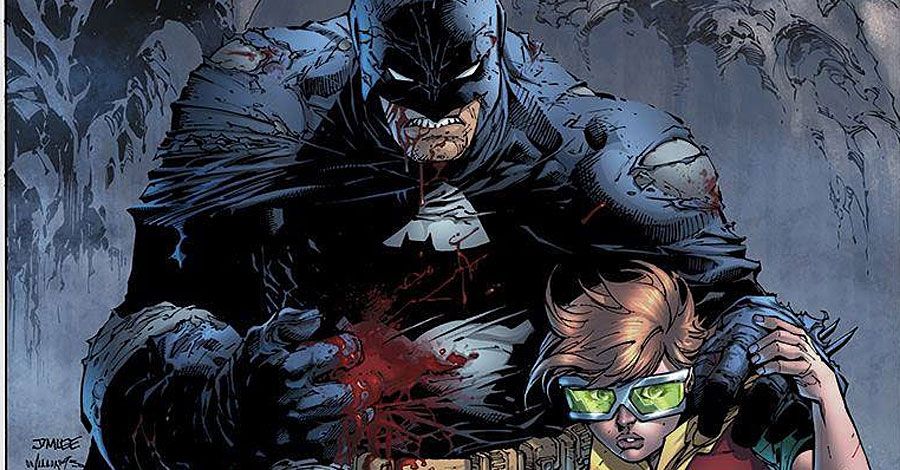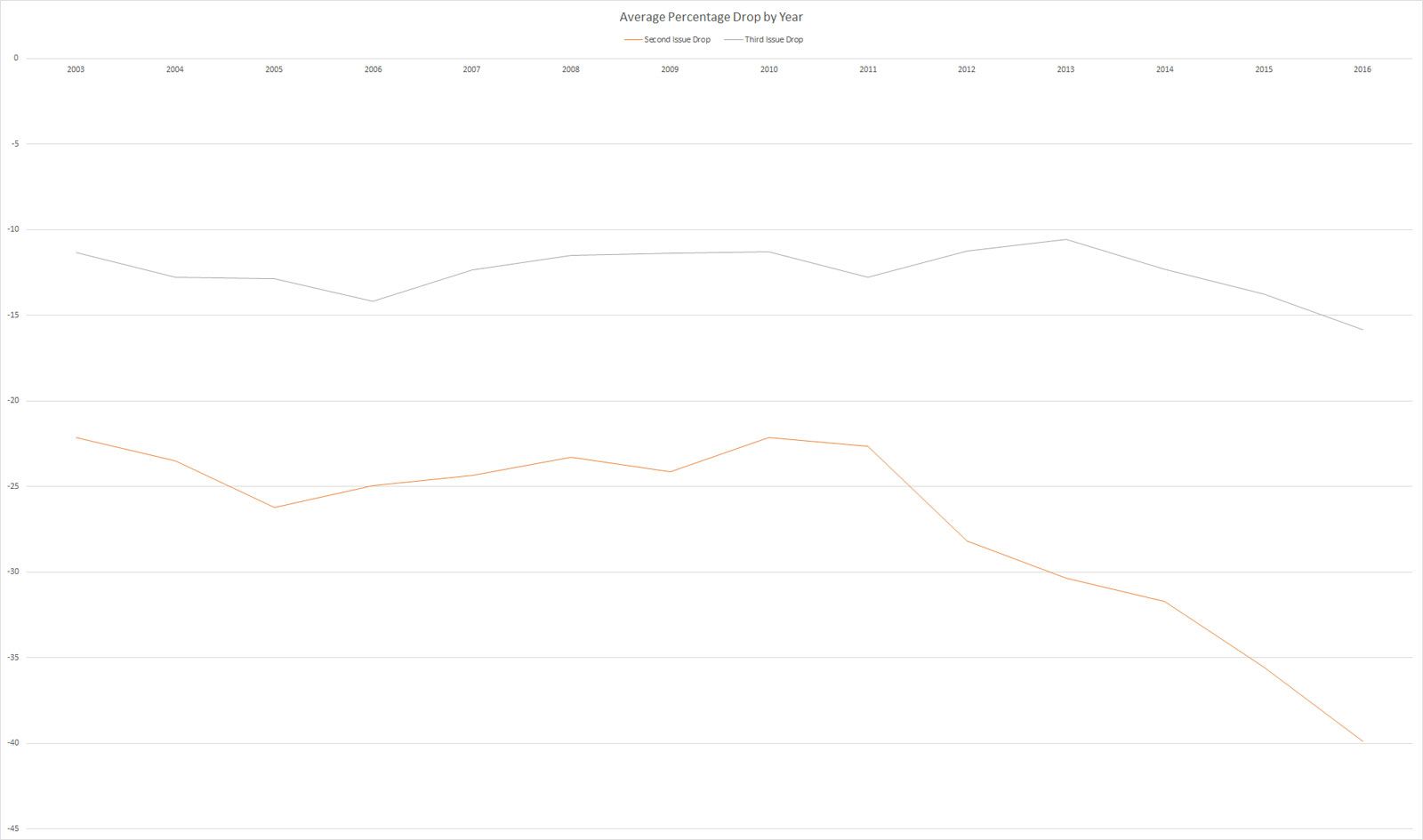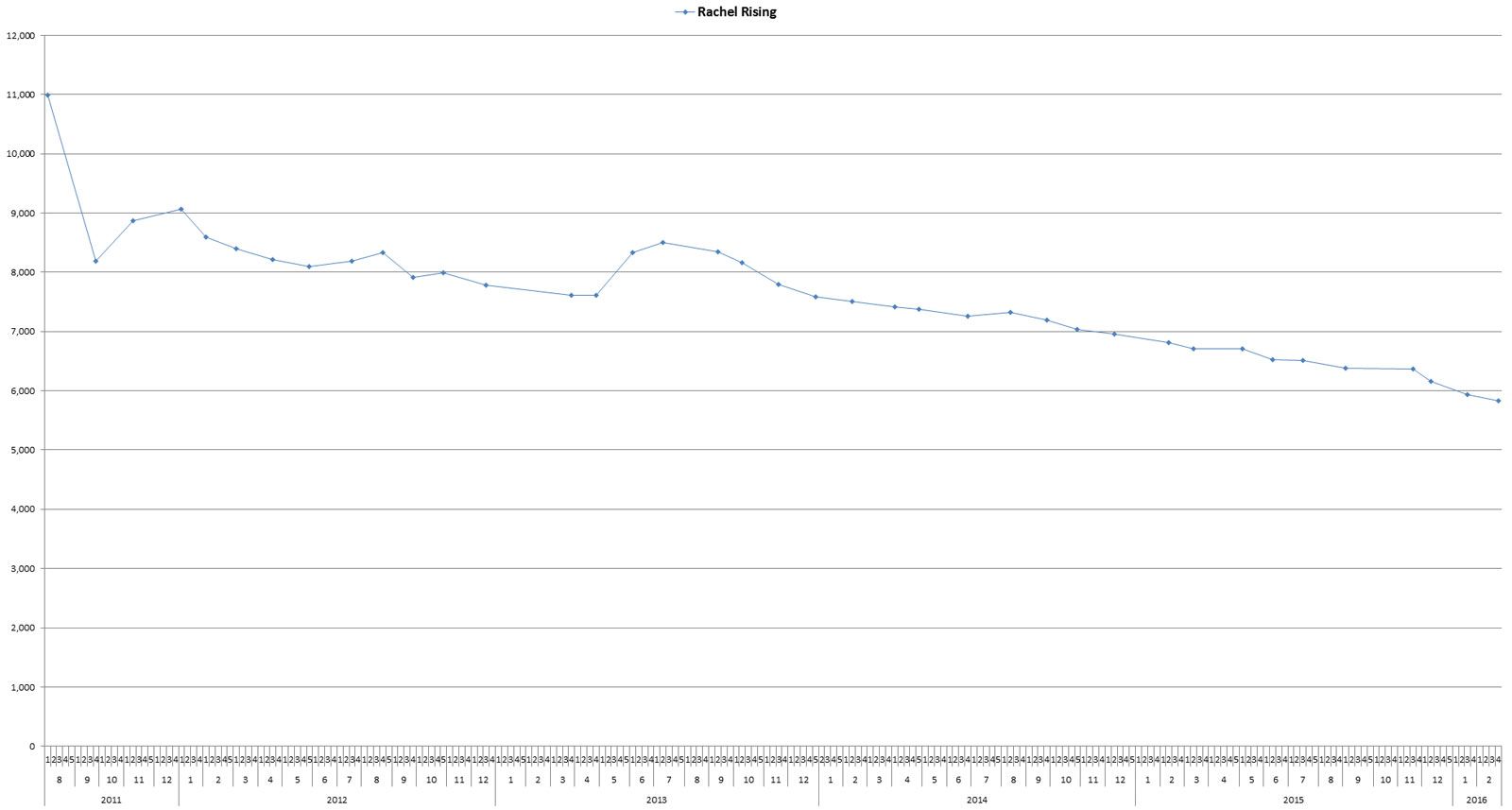DC Comics increased its unit sales for the top 300 comics while Marvel decreased unit sales compared to last month in February 2016. The top 300 comics totaled to 6,089,822 units which is about 500,000 units below the historical average of 6,579,683 and about 1,322,000 units below the average of 7,411,965 for the past 12 months. The retail dollar total of $24,345,863.06 for the top 300 comics was more than $2,000,000 above the historical average of 22,157,601.79 but almost $5,000,000 below the $29,282,103.30 average for the past 12 months. Historical averages are calculated using the data starting in March 2003 when Diamond first started released sales data based on sales instead of preorders.
RELATED: Only Three Titles Top 100K In February's Direct Market Sales
Topping the comics list in February 2016 was "Dark Knight III: Master Race" #3 with 146,043 units. "Star Wars" #16 and "Batman" #49 were the only other two titles over 100,000 units. Both titles were up a few percent from the previous issue. The 10.53% drop on "Dark Knight III: Master Race" #3 is less than the historical average for a third issue drop of 12.28%. The average second and third issue drops have been increasing over the past few years. A second issue drop of 22% to 26% was the norm between 2003 and 2011. From 2012 to 2015 the second issue drop has been averaging between 28% and 36% with 2016 averaging nearly 40% in January and February.
The obvious takeaway is readers are getting more selective in what they read. At best, a title only has two or three issues before most of the potential readers have dropped the title. The second issues of "Spider-Man/Deadpool," "Harley's Little Black Book," "Rocket Raccoon and Groot," "Karnak" and "Silver Surfer" each dropped by over 50%. Heavy promotion and additional incentive covers on the first issues inflating the first issues sales is another factor. All of this just goes to show how misleading high first issue sales can be as any sort of gauge of how a title is doing.
At Marvel, The Miles Morales-helmed "Spider-Man" #1 launched just under 100,000 units with 99,950 units which is much better than the 75,357 units for "Amazing Spider-Man" #7 and the 71,599 units for "Amazing Spider-Man" #8 which feature the Peter Parker Spider-Man. In a distant third is the Miguel O-Hara Spider-Man from the future, who is also swinging around the modern day New York in "Spider-Man 2099" #6 which sold 26,626 units and "Spider-Man 2099" #7 which sold 26,163 units. "Spidey" #3 sold 28,161 units. That title features early adventures of the Peter Parker Spider-Man. Or, at least, I think it does. With that many Spider-Man comics being published featuring that many different Spider-Men in the same continuity, it gets a little challenging to keep it all straight.
"Deadpool: Mercs for the Money" #1 sold 90,196 units, putting it above the $9.99 25th anniversary issue of "Deadpool" #7 which sold 88,264 units, and thanks to the higher price, it also brought in more retail dollars. A ComicConBox exclusive cover of "Deadpool: Mercs for the Money" #1 was in the February 2016 ComicConBox. An exclusive cover of "Deadpool" #1 was in the February 2016 Marvel Collector Corp subscription box which might help explain the 81,239 units of reorder activity on that issue back in the December numbers.
Marvel ongoing titles under 20,000 units include "Star Lord," "Vision," "Agents of S.H.I.E.L.D.," "New Avengers," "Nova," "Unbeatable Squirrel Girl," "Patsy Walker Aka Hellcat," " Angela: Queen of H'el," " Illuminati," "Moon Girl and Devil Dinosaur," "Drax," "Black Knight," "Weirdworld," "Hercules," "Howling Commandos of S.H.I.E.L.D.," "Red Wolf" and "Starbrand and Nightmask." Of those, only "Black Knight" has been cancelled. A few of those might stick around longer than sales might otherwise warrant, such as "Agents of "S.H.I.E.L.D." since it could be considered a gateway from the television show into the comic book universe. "Unbeatable Squirrel Girl," "Patsy Walker Aka Hellcat" and "Moon Girl and Devil Dinosaur" might also get a little more time to find an audience since they help to diversify the Marvel lineup in terms of characters and styles of comic books.
"Red Wolf" is perhaps the most disappointing item in the list, because it is one of the lowest selling of the bunch, and it has the biggest disconnect between what it could have been and what it is. No doubt many readers were expecting to get more stories set in the old West town of Timely in 1872 only to be surprised and perhaps disappointed to not get that. Going from initial sales of 39,288 units to just 12,211 units by the third issue means a second story arc is unlikely.
At DC, "Justice League" #48, "Batman/Teenage Mutant Ninja Turtles" #3 and "Harley Quinn" #25 were the only other titles over 50,000 units. The information about Rebirth is a little surprising considering how some titles are currently selling. "New Suicide Squad" #17 sold 23,687 units which isn't bad for a DC ongoing title. I don't think those are strong enough sales to justify a twice monthly "Suicide Squad" book, but with Jim Lee providing art, we should expect those numbers to go up. The 26,533 units for "Deathstroke" #15 are slightly better, but also make the twice monthly decision for that title questionable. The 18,091 units for "Cyborg" #8 make the decision go twice monthly with a new "Cyborg" series seem like a potentially bad idea. It is entirely possible that increasing the frequency will help the story momentum and help those titles, but there is little evidence such a thing will happen. The announcement of "Gotham Academy: Next Semester" is also a bit surprising, given "Gotham Academy" #15 sold 14,334 units.
With most DC titles selling under 40,000 units, they needed to do something to shake things up and try to get readers to buy their titles. Frequent relaunches and faster release scheduled have worked for Marvel, at least as much as anything seems to work, so probably shouldn't be too surprising that DC is borrowing from Marvel's play book.
"Harley Quinn" #25 sold 51,495 units, up 14.52% thanks to the Joker appearing in that issue. Even with the increase in sales over the previous issue, however, it was still the second lowest selling issue of the series.
Over at Image, "The Walking Dead" #151 sold 67,380 units, up almost 2,000 from the sales of "The Walking Dead" #149. The additional 90,000 or so units sold of "The Walking Dead" #150 seems to have had no lasting impact on sales so far, as expected. Robert Kirkman has gotten his sales the old fashion way: with good storytelling over the long term. While "The Walking Dead" has had issues with incentive covers, that isn't how Kirkman generally increases sales on the title.
"Saga" #34 sold 49,363 units and "Paper Girls" #5 with 37,206 units, "I Hate Fairyland" #5 with 24,793 units, "Outcast" #16 with 21,801 units and "Huck" #4 with 20,183 units were the only other Image titles to sell over 20,000 units. "Spawn" #260 sold 17,876 units, up 5.74% over the previous issue.
"Back to the Future" #5 sold 21,195 units at IDW. The next issue starts a new story arc as the title converts to an ongoing title. IDW is also doing a "Back to the Future: Citizen Brown" miniseries which adapts the "Back to the Future" videogame. Sales are up over the previous issue on "Teenage Mutant Ninja Turtles," "My Little Pony: Friendship is Magic," "Transformers," "G.I. Joe: A Real American Hero," "Star Trek" and "X-Files: Season 11." IDW continues to manage a large number of licensed properties and do a good job on them.
Dynamite Entertainment seems to be going through a repositioning phase. "James Bond" #4 was the only Dynamite Entertainment title in the top half of the list with 16,837 units. We've seen this sort of phase every once in a while at a few of the middle tier publishers like Dark Horse, IDW, BOOM! Studios and currently Dynamite Entertainment.
At Valiant, "Faith" #2 dropped 44.29% to 22,019 units which is still a strong seller for the publisher. With only two more issues left, Terry Moore's "Rachel Rising" continues to be a reasonably consistent seller with only a percent or two fall off per issue.
The unfortunate truth of the matter is, almost every title loses sales with every issue. Often, it is just a few percent but that adds up over time. Years ago, "Spawn" was the best-selling ongoing title at Image and now "The Walking Dead" is selling nearly four times as much. The key to long term sales is reader retention. If you can't maintain sales, then you can't grow sales over time. Relaunching doesn't solve that problem neither does incentive covers. Dumping the back story for the character or re-embracing it isn't the solution either.
The key to comic book sales success is for the comic to entertain and satisfy the readers with every issue. Easy to say, hard to do. Odd as it might seem, the burden isn't entirely on the publishers and creators. We, the readers, need to communicate what is and isn't working as clearly and constructively as possible to retailers, publishers and creators. We need to understand that disliking something isn't the same as it being bad. We all have different tastes in comics, and no particular preference is superior to the others. There are more than enough comics to go around. The trick is to be matching the readers with the comics they'll like and to provide the creators and publishers the information they need to please the appropriate audience for each comic. At that point, it is up to the creators and publishers to take action on that constructive feedback and provide an assortment of comics to please as wide an audience as possible. Then, and only then, will we see sales stabilizing and starting to go up as the norm and sales attrition going away.
If you'd like to listen to an in-depth discussion of the sales data, check out the Mayo Report episodes of the Comic Book Page podcast at www.ComicBookPage.com covering the past decade of comic book sales. In addition to those episodes, every Monday is a Weekly Comics Spotlight episode featuring a comic by DC, a comic by Marvel and a comic by some other publisher. I read around 200 new comics a month so the podcast covers a wide variety of what is currently being published. If you are looking for more or different comics to read, check out the latest Previews Spotlight episode which features clips from various comic book fans talking about the comics they love. With thousands of comics in Previews every month, Previews Spotlight episodes are a great way to find out about things which may have flown under your comic book radar.
As always, if you have any questions or comments, please feel free to email me at John.Mayo@ComicBookResources.com.



